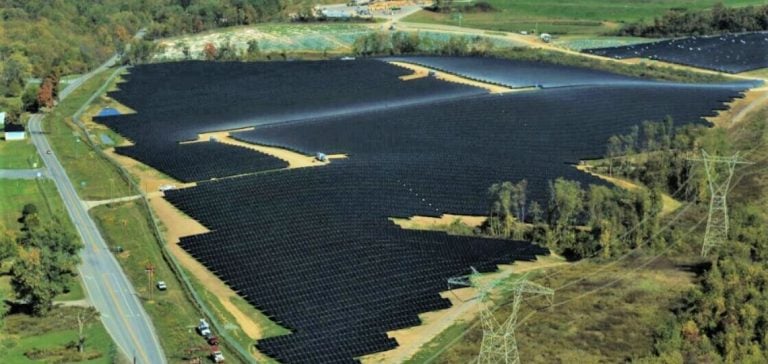Mon Power and Potomac Edison have begun construction of a third solar site in Berkeley County, West Virginia.
The project is part of a program launched in response to local 2020 legislation that authorizes electric utilities to develop solar infrastructure to a maximum of 200 megawatts.
The aim is to diversify the state’s electricity supply while attracting businesses keen to consume a share of renewable energy.
The 36-acre site used for the project, formerly an ash dump associated with the R. Paul Smith power plant, was rehabilitated in 2022 after the removal of over three million tons of ash.
Today, the conversion of this area into a solar power plant marks a new stage in the optimization of land use to meet local energy challenges.
The project aims to produce 5.75 megawatts of solar electricity, enough to power around 1,000 homes.
This production is part of a long-term strategy by Mon Power and Potomac Edison to deploy several solar installations in the state, totaling 50 megawatts in a first phase.
A response to market and investor expectations
One of the main drivers behind these projects is the growing demand for renewable energy among businesses.
Indeed, more and more companies are demanding that their electricity consumption include a share of green energy, a condition now often required for their local location.
West Virginia, historically associated with coal, is striving to diversify its energy mix to attract investors while maintaining its competitiveness.
The legislative framework introduced in 2020 enables local companies to offer renewable solutions to large consumers, while continuing to meet the energy needs of the residential and industrial sectors.
This project in Berkeley County illustrates how former industrial sites can be redeveloped to meet the new demands of the energy market.
Solar panels, steel support systems and electrical equipment are sourced exclusively from U.S.-based suppliers, in line with efforts to stimulate the local economy while ensuring infrastructure quality and sustainability.
Economic and environmental benefits for the State
The development of solar infrastructures by Mon Power and Potomac Edison is not limited to energy production.
It also represents a lever for economic growth in the region.
The use of local unionized labor for construction supports employment and builds capacity in the region’s renewable energy sector.
The two companies’ solar program also offers Solar Renewable Energy Credits (SRECs) to interested customers.
These certificates are issued for each megawatt-hour of solar electricity generated, and can be purchased by companies or individuals wishing to offset their consumption of non-renewable energy.
This incentive mechanism enhances the ecological footprint of companies while creating a new source of revenue for Mon Power and Potomac Edison.
The first companies to sign up to this program include the National Energy Technology Laboratory (NETL) in Morgantown and the town of Harpers Ferry.
Other major energy consumers are expected to join the movement quickly, spurred on by competitive rates and the need to integrate more renewable sources into their energy portfolios.
Future prospects for the program
The solar program initiated by Mon Power and Potomac Edison in West Virginia is rolling out fast, with five projects under development, each bringing additional capacity to the local energy grid.
In addition to the Berkeley County project, the two companies have already completed an 18.9-megawatt installation at the Fort Martin Power Station, and are advancing construction of another site in Rivesville, which will generate 5.5 megawatts of solar power.
Once completed, these infrastructures will enable West Virginia to position itself competitively in the renewable energy market, meeting both legal requirements and growing business demand.
The 2020 legislative framework continues to provide opportunities for growth and innovation in the sector, while ensuring that the state remains an attractive hub for industries.
With this in mind, Mon Power and Potomac Edison still have several projects awaiting approval from the West Virginia Public Service Commission, including sites in Davis and Weirton, for a total of 19.9 additional megawatts.
These projects will only be launched once 85% of the renewable energy credits generated by these facilities have been reserved by customers, thus ensuring a stable return on investment.
By encouraging subscription to SRECs and developing strategic partnerships, the two companies are actively participating in the transformation of the region’s energy landscape.






















